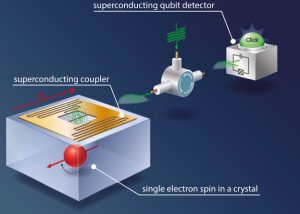The research in the coming years will focus on the applications of single-electron-spin detection with a microwave counter, both in quantum computing, and in EPR spectroscopy.
In quantum computing, we will investigate a new quantum processor architecture based on individual nuclear spins in solids. (This research is funded by the PEPR RobustSuperQ.) The appeal of such architecture is that nuclear spin qubits have coherence time that can reach several minutes, many orders of magnitude longer than usual superconducting qubits. Nuclear spin qubits can be initialized and measured through the hyperfine interaction with a neighboring electron spin, which itself can be measured using microwave photon counting as we recently demonstrated. Single-qubit gates are performed by application of radio-frequency pulses at the nuclear spin frequency. Two-qubit gates are performed via the interaction with the electron spin, which itself can be made to interact with another electron spin by their mutual interaction with a common resonator.
To achieve this goal, we first wish to increase the coupling of electron spins to resonators. This is essential as it is the factor limiting the measurement time, as well as the speed of 2-qubit gates. Presently, with Er3+ ions in a CaWO4 matrix coupled to a 300nm wide wire at 7GHz, we can achieve coupling strengths of 6kHz. We wish to reach at least 30kHz, which would speed up the measurements by a factor 25. Reaching this value will be possible by: using an ion/matrix combination with a larger gyromagnetic ratio, narrowing down the nanowire transverse dimensions, and lowering the resonator impedance by optimizing its geometry. With such a strong coupling, the electron spin will decay in a few tens of microseconds if it is at the resonator frequency. Therefore, it becomes essential to tune the resonator frequency dynamically, so that the spin can be detuned and protected from radiative relaxation during the quantum state manipulation sequence, and tuned to resonance for readout. To achieve these goals, we envision to use a Bragg Mirror architecture, which enables passing dc current through the resonator, and tuning its frequency because of the current-dependence of the kinetic inductance. We will then be in a good position to demonstrate a gate between 2 Er3+ ions coupled to the same resonator, and in a second step to perform this gate between 183W nuclear spins coupled to each ion. In parallel, we intend to design a complete processor architecture and put it in practice in the years to come.




